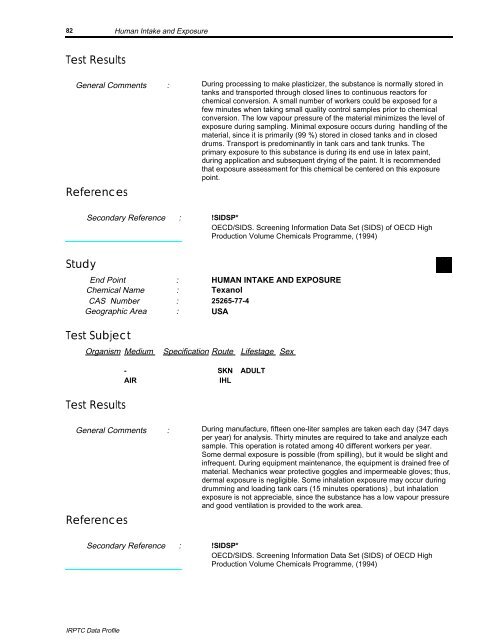TEXANOL CAS N°: 25265-77-4
TEXANOL CAS N°: 25265-77-4
TEXANOL CAS N°: 25265-77-4
Create successful ePaper yourself
Turn your PDF publications into a flip-book with our unique Google optimized e-Paper software.
82<br />
Human Intake and Exposure<br />
Test Results<br />
General Comments : During processing to make plasticizer, the substance is normally stored in<br />
tanks and transported through closed lines to continuous reactors for<br />
chemical conversion. A small number of workers could be exposed for a<br />
few minutes when taking small quality control samples prior to chemical<br />
conversion. The low vapour pressure of the material minimizes the level of<br />
exposure during sampling. Minimal exposure occurs during handling of the<br />
material, since it is primarily (99 %) stored in closed tanks and in closed<br />
drums. Transport is predominantly in tank cars and tank trunks. The<br />
primary exposure to this substance is during its end use in latex paint,<br />
during application and subsequent drying of the paint. It is recommended<br />
that exposure assessment for this chemical be centered on this exposure<br />
point.<br />
References<br />
Secondary Reference : !SIDSP*<br />
OECD/SIDS. Screening Information Data Set (SIDS) of OECD High<br />
Production Volume Chemicals Programme, (1994)<br />
Study<br />
End Point : HUMAN INTAKE AND EXPOSURE<br />
Chemical Name : Texanol<br />
<strong>CAS</strong> Number : <strong>25265</strong>-<strong>77</strong>-4<br />
Geographic Area : USA<br />
Test Subject<br />
Organism Medium Specification Route Lifestage Sex<br />
Test Results<br />
- SKN ADULT<br />
AIR<br />
IHL<br />
General Comments : During manufacture, fifteen one-liter samples are taken each day (347 days<br />
per year) for analysis. Thirty minutes are required to take and analyze each<br />
sample. This operation is rotated among 40 different workers per year.<br />
Some dermal exposure is possible (from spilling), but it would be slight and<br />
infrequent. During equipment maintenance, the equipment is drained free of<br />
material. Mechanics wear protective goggles and impermeable gloves; thus,<br />
dermal exposure is negligible. Some inhalation exposure may occur during<br />
drumming and loading tank cars (15 minutes operations) , but inhalation<br />
exposure is not appreciable, since the substance has a low vapour pressure<br />
and good ventilation is provided to the work area.<br />
References<br />
Secondary Reference : !SIDSP*<br />
OECD/SIDS. Screening Information Data Set (SIDS) of OECD High<br />
Production Volume Chemicals Programme, (1994)<br />
IRPTC Data Profile
















